
5G technology

All around the world people are developing 5G wireless technology. Which have higher bandwidth than 4G. With 5G people can go garden hose to river with that bandwidth. Industries that are developing with edge compute with 5G can archive more online real-time processes than ever. Specially Automobiles with autopilot and mobile devices.
5G will be the catalyst for edge computer technology. And applicants who using 5G will change traffic demand patterns, providing biggest drive for the edge computer technology in mobile network. It’s clear that initial goal edge computing was to reduce bandwidth cost IoT devices over long distance. Growth of real-time applications that require local processing and storage capabilities will drive the technology forward next few years.
5G is the 5th generation mobile network. it’s a global wireless trend after 1G, 2G, 3G, and 4G networks. 5G enables a new type of network that designed to connect virtually everyone and everything together including machines, objects and devices. This wireless technology is suppose to deliver higher speed with ultra-low latency, more reliability, massive network capacity, increased availability and a more uniform user experience to more uses. Higher speed and better efficiency empower new user experiences and connect new industries.
The previous generations of mobile networks and 5G
The previous generations of mobile networks are 1G, 2G, 3G, and 4G networks.
First-generation – 1G Came in the 1980s and 1G delivered analog voice. The Second generation – 2G In the early 1990s: 2G introduced digital voice also known as Code Division Multiple Access(CDMA). Third generation – 3G Came In the early 2000s: 3G brought mobile data (CDMA2000). Fourth-generation – 4G LTE Came in the 2010s 4G LTE ushered in the era of mobile broadband. 1G, 2G, 3G and 4G all led to 5G, which is considere to provide more connectivity than ever available before with speed and higher bandwidth.
5G may be unified as the more capable air interface. It’s design with an extended capacity to enable next-generation user experiences and permit new deployment models and deliver new services.
With high speeds, superior reliability and insignificant latency with low bandwidth, 5G will expand the mobile network into new realms. 5G will impact every industry, making safer transportation, remote healthcare, precision agriculture, and Edge computing, digitized logistics and more a reality will make a huge difference.
How will 5G affect the global economy?

5G is driving global growth in almost every industry. More like robotic process automation (RPA), Edge computing, Internet of Things and with more trending technologies. With 5G technology industries will make 13.1 Trillion dollars of worldwide economic output. And will create above $22.8 Million new jobs for the world like professional consultant predict. And also $265 billion global 5G CAPEX and R&D annually over subsequent 15 years.
Analyze through the 5G Economy, we find that 5G’s full economic effect will likely realize across the world by 2035 by supporting a good range of industries. And potentially create up to $13.1 trillion worth of products and services. This impact is huge than previous network generations. The growth requirements of the new 5G network also are expanding beyond the normal mobile networking to industries like the autonomous industry.
The study also revealed that the 5G value chain (including OEMs, operators, content creators, app developers, and consumers) could alone support up to 22.8 million jobs, or quite one job for each person in Beijing, China. And many emerging new applications will still define within the future. Only time will tell what is the complete effect of 5G technology on the economy goes to be.
Where is 5G being used?
Broadly speaking, 5G is use across three main kinds of connecting services. Including enhanced mobile broadband, mission-critical communications and therefore the massive IoT. A defining capability of 5G is its’s design to forwarding compatibility. And also the ability to flexibly support future services that are coming to play.
In addition to creating our smartphones better, 5G mobile technology can usher new immersive experiences like VR and AR with faster. And more uniform data rates, lower latency, and lower cost-per-bit. 5G can enable new services which will transform industries with ultra-reliable, available, low-latency links like remote critical infrastructure, vehicles, and medical procedures.
5G is suppose to seamlessly connect a huge number of embedded sensors in virtually everything through the power to scale down in data rates, power, and mobility providing extremely lean and low-cost connectivity solutions.
How fast is 5G network ?
5G is design to deliver peak data rates up to twenty gigabits per second supported IMT-2020 requirements. But 5G is about quite just how risky it is. Additionally, to higher peak data rates, 5G is meant to supply far more network capacity by expanding into the new spectrum. 5G also can deliver much lower latency for a more immediate response and may provide an overall more uniform user experience. So that the data rates stay consistently high even when the user is traveling. And therefore the new 5G NR mobile network is protect by a Gigabit LTE coverage foundation. Which may provide a ubiquitous Gigabit-class network and connection.
All around the world people are developing 5G wireless technology. Which have higher bandwidth than 4G. With 5G people can go garden hose to river with that bandwidth. Industries that are developing with edge compute with 5G can archive more online real-time processes than ever. Specially Automobiles with autopilot and mobile devices. 5G will…


